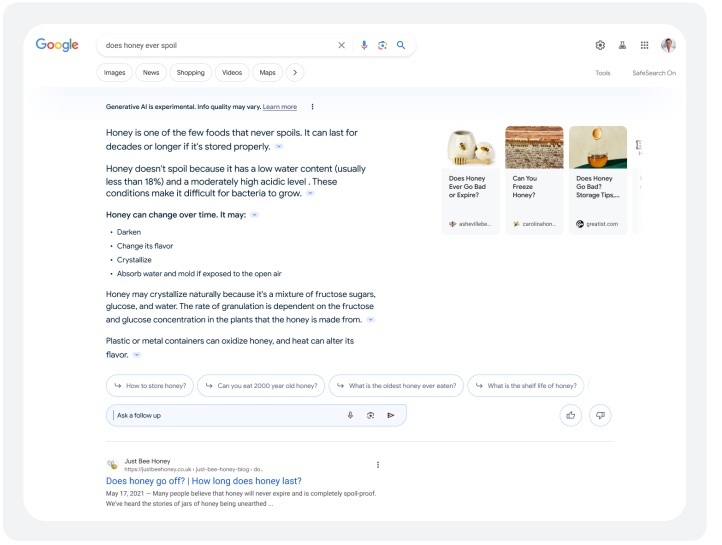
What is Google SGE?
Google Search Generative Experience (SGE) represents a new way of displaying search results. It is a search that utilizes generative artificial intelligence to provide users with quick answers to their queries without having to click on individual web pages.
With generative AI in search, people can:
- Ask new types of questions that are more complex and detailed.
- Quickly get basic information about a topic with links to relevant results.
- Instantly start tasks such as writing texts or generating images.
- Easily continue searching through conversational queries or by using suggested next steps.
For example, if you are looking for things to do during the summer holidays, Google previously directed you to pages with activity ideas. With SGE, Google will provide a list of suggestions at the top of the results, compiled from multiple sources.

How SGE Works
Simply put, generative artificial intelligence refers to algorithms or models that can create content, including text, images, audio, and even code.
Generative AI systems work on large language models (LLMs) trained on massive amounts of data. For instance, the LLM named GPT-4 powers Bing and ChatGPT. Similarly, Google uses an LLM known as the Pathways Language Model 2 (PaLM 2).
This is the same technology Google uses in its other products that have adopted generative AI, such as the “Help me write” feature in Gmail.
Google’s generative AI search utilizes various AI-based technologies, including natural language processing, machine learning, and deep learning. These technologies enable the search engine to understand the user’s query, process relevant content, and formulate an appropriate response.
Main Benefits of SGE
- Simple Overview of Complex Topics
Google SGE provides an easily understandable summary of complex topics, allowing users to quickly grasp the basics without getting lost in details.
For example, if you ask Google, “What are PFAS chemicals?”, you will receive a quick overview of the main points without diving into excessive details or technicalities.
- Conversational Results
SGE offers a more interactive experience than traditional search. Google suggests not only related questions but also logical follow-up queries, helping users get highly relevant and detailed information with just a few clicks.
For instance, if you ask Google to compare spinach and kale, it will suggest interesting follow-up questions, such as the three main benefits and which vegetable is best for maintaining an anti-inflammatory diet.
- Quick and Direct Information
SGE simplifies the process of obtaining information, allowing users to find what they are looking for more directly and faster than sifting through multiple web pages.
A search query like “How is the periodic table arranged?” will provide both a textual and visual answer. Google will explain how the elements are arranged and how many rows and columns the periodic table has.

Possible Drawbacks of Google’s Generative AI Search
- Potential for Inaccuracies
The new search is still in development. Language models themselves can sometimes “hallucinate” and produce incorrect information. Therefore, Google SGE displays a warning: “Generative AI is experimental. The quality of information may vary.”
For example, if you are looking for medical information, such as “how to prevent heart disease”, Google SGE will display an additional warning that the search result is “not medical advice” and encourages users to consult their doctor.
- Reduced Visibility for Paid Search
Google search ads are a major revenue source for many companies, so Google will need to proceed carefully to ensure SGE does not diminish their significance. However, Google has already started experimenting with AI ads and is testing placements and formats that integrate well with search results.
- Lack of Transparency
Google PaLM 2 is a closed model, meaning it does not disclose much about its decision-making process. This lack of transparency conflicts with users’ desire to understand how AI arrives at a particular conclusion.
Generative AI has potential advantages and disadvantages when it comes to SEO
Google Search Generative Experience (SGE) could significantly reduce organic web traffic. By providing answers directly in the search engine, users may not click on links to individual web pages, leading to a decrease in visits that would otherwise come from the search engine.
- Let’s first look at how generative AI might harm traffic.
If users obtain most of the information they need directly from AI-powered summaries, they may not click through to websites, including yours.
The answers from SGE are so detailed that users might decide not to click on the websites that originally provided the information. While Google still cites these sites as sources, the value of these links for “what is” queries will likely decline.
- Now, let’s look at how SGE might bring high-quality traffic to your site.
Google described SGE as “a starting point to explore content on the web.” While website traffic for basic queries may decline, most people will still need to search for more detailed information.
The good news is that when someone finally visits your website, they will likely be well-informed and ready to convert. It’s also important to note that Google combines generative content with traditional search results. Traditional results are still available below the AI-generated answer.
Additionally, only users who have opted into using SGE will see AI-generated results. Many users still rely on traditional search to find information.
How to Optimize Your Website for SGE (Search Generative Experience)
- Quality and Relevant Content
- Create detailed and well-structured content.
- Regularly update content.
- Structured Data (Schema Markup)
- Implement structured data.
- Ensure the data is accurate and complete.
- Optimization for Rich Snippets
- Write clear and concise answers to common questions.
- Use lists, tables, and charts.
- Increasing Authority and Trustworthiness
- Acquire high-quality backlinks.
- Publish authoritative content.
- Optimization for Mobile Devices
- Ensure the website is mobile-friendly.
- Speed up page loading times.
- Interactive Content
- Embed videos, infographics, and interactive elements.
- Engage users through polls and surveys.
- Monitoring and Analyzing Performance
- Use web analytics tools.
- Optimize based on data.
Need help preparing for the Search Generative Experience? Feel free to contact us, we’ll be happy to help.


